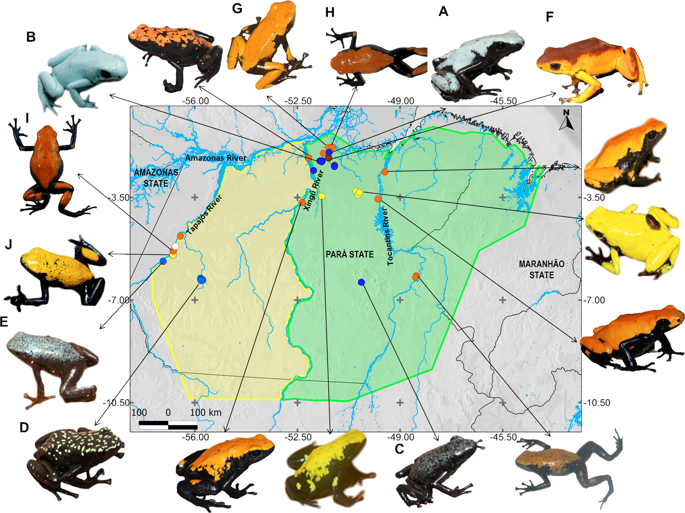Our official English website, www.x-mol.net, welcomes your feedback! (Note: you will need to create a separate account there.)
The evolution of polymorphism in the warning coloration of the Amazonian poison frog Adelphobates galactonotus
Heredity ( IF 3.8 ) Pub Date : 2019-11-11 , DOI: 10.1038/s41437-019-0281-4 Diana Rojas 1, 2 , Albertina P Lima 3 , Paolo Momigliano 4 , Pedro Ivo Simões 3, 5 , Rachael Y Dudaniec 6 , Teresa C Sauer de Avila-Pires 7 , Marinus S Hoogmoed 7 , Youszef Oliveira da Cunha Bitar 8 , Igor L Kaefer 9 , Adolfo Amézquita 10 , Adam Stow 6
Heredity ( IF 3.8 ) Pub Date : 2019-11-11 , DOI: 10.1038/s41437-019-0281-4 Diana Rojas 1, 2 , Albertina P Lima 3 , Paolo Momigliano 4 , Pedro Ivo Simões 3, 5 , Rachael Y Dudaniec 6 , Teresa C Sauer de Avila-Pires 7 , Marinus S Hoogmoed 7 , Youszef Oliveira da Cunha Bitar 8 , Igor L Kaefer 9 , Adolfo Amézquita 10 , Adam Stow 6
Affiliation

|
While intraspecific variation in aposematic signals can be selected for by different predatory responses, their evolution is also contingent on other processes shaping genetic variation. We evaluate the relative contributions of selection, geographic isolation, and random genetic drift to the evolution of aposematic color polymorphism in the poison frog Adelphobates galactonotus, distributed throughout eastern Brazilian Amazonia. Dorsal coloration was measured for 111 individuals and genetic data were obtained from 220 individuals at two mitochondrial genes (mtDNA) and 7963 Single Nucleotide Polymorphisms (SNPs). Four color categories were described (brown, blue, yellow, orange) and our models of frog and bird visual systems indicated that each color was distinguishable for these taxa. Using outlier and correlative analyses we found no compelling genetic evidence for color being under divergent selection. A time-calibrated mtDNA tree suggests that the present distribution of dorsal coloration resulted from processes occurring during the Pleistocene. Separate phylogenies based on SNPs and mtDNA resolved the same well supported clades, each containing different colored populations. Ancestral character state analysis provided some evidence for evolutionary transitions in color type. Genetic structure was more strongly associated with geographic features, than color category, suggesting that the distribution of color is explained by localized processes. Evidence for geographic isolation together with estimates of low effective population size implicates drift as playing a key role in color diversification. Our results highlight the relevance of considering the neutral processes involved with the evolution of traits with important fitness consequences.
中文翻译:

亚马逊毒蛙 Adelphobates galactonotus 警戒色多态性的演化
虽然警戒信号的种内变异可以通过不同的捕食反应来选择,但它们的进化也取决于塑造遗传变异的其他过程。我们评估了选择、地理隔离和随机遗传漂变对分布在巴西亚马逊流域东部的毒蛙 Adelphobates galactonotus 的颜色多态性进化的相对贡献。对 111 名个体的背部颜色进行了测量,并从 220 名个体中获得了两个线粒体基因 (mtDNA) 和 7963 个单核苷酸多态性 (SNP) 的遗传数据。描述了四种颜色类别(棕色、蓝色、黄色、橙色),我们的青蛙和鸟类视觉系统模型表明,每种颜色对于这些分类单元都是可区分的。通过异常值和相关分析,我们发现没有令人信服的遗传证据表明颜色处于不同的选择之下。经过时间校准的 mtDNA 树表明,目前背部颜色的分布是更新世期间发生的过程造成的。基于 SNP 和 mtDNA 的单独系统发育解析了相同的得到良好支持的进化枝,每个进化枝都包含不同颜色的种群。祖先性格状态分析为颜色类型的进化转变提供了一些证据。与颜色类别相比,遗传结构与地理特征的相关性更强,这表明颜色的分布可以通过局部过程来解释。地理隔离的证据以及对低有效种群规模的估计表明漂移在颜色多样化中发挥着关键作用。我们的结果强调了考虑具有重要适应性后果的性状进化所涉及的中性过程的相关性。
更新日期:2019-11-11
中文翻译:

亚马逊毒蛙 Adelphobates galactonotus 警戒色多态性的演化
虽然警戒信号的种内变异可以通过不同的捕食反应来选择,但它们的进化也取决于塑造遗传变异的其他过程。我们评估了选择、地理隔离和随机遗传漂变对分布在巴西亚马逊流域东部的毒蛙 Adelphobates galactonotus 的颜色多态性进化的相对贡献。对 111 名个体的背部颜色进行了测量,并从 220 名个体中获得了两个线粒体基因 (mtDNA) 和 7963 个单核苷酸多态性 (SNP) 的遗传数据。描述了四种颜色类别(棕色、蓝色、黄色、橙色),我们的青蛙和鸟类视觉系统模型表明,每种颜色对于这些分类单元都是可区分的。通过异常值和相关分析,我们发现没有令人信服的遗传证据表明颜色处于不同的选择之下。经过时间校准的 mtDNA 树表明,目前背部颜色的分布是更新世期间发生的过程造成的。基于 SNP 和 mtDNA 的单独系统发育解析了相同的得到良好支持的进化枝,每个进化枝都包含不同颜色的种群。祖先性格状态分析为颜色类型的进化转变提供了一些证据。与颜色类别相比,遗传结构与地理特征的相关性更强,这表明颜色的分布可以通过局部过程来解释。地理隔离的证据以及对低有效种群规模的估计表明漂移在颜色多样化中发挥着关键作用。我们的结果强调了考虑具有重要适应性后果的性状进化所涉及的中性过程的相关性。



























 京公网安备 11010802027423号
京公网安备 11010802027423号